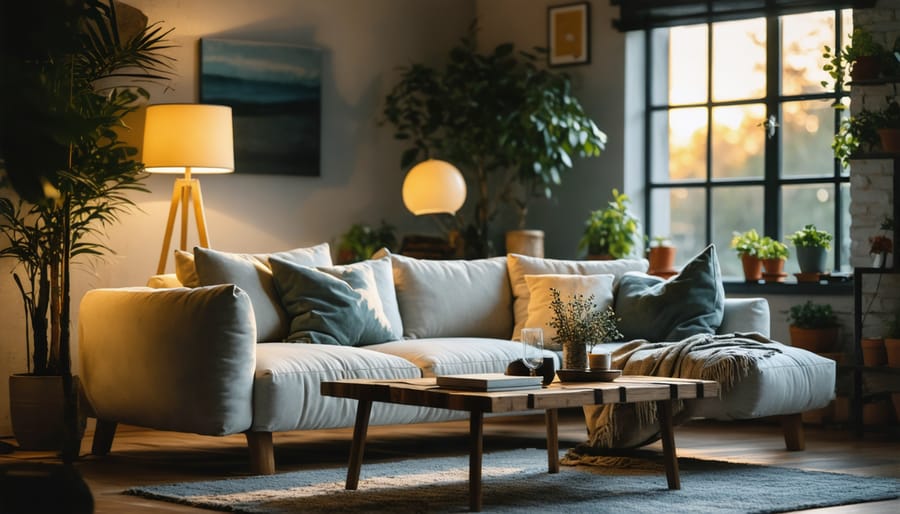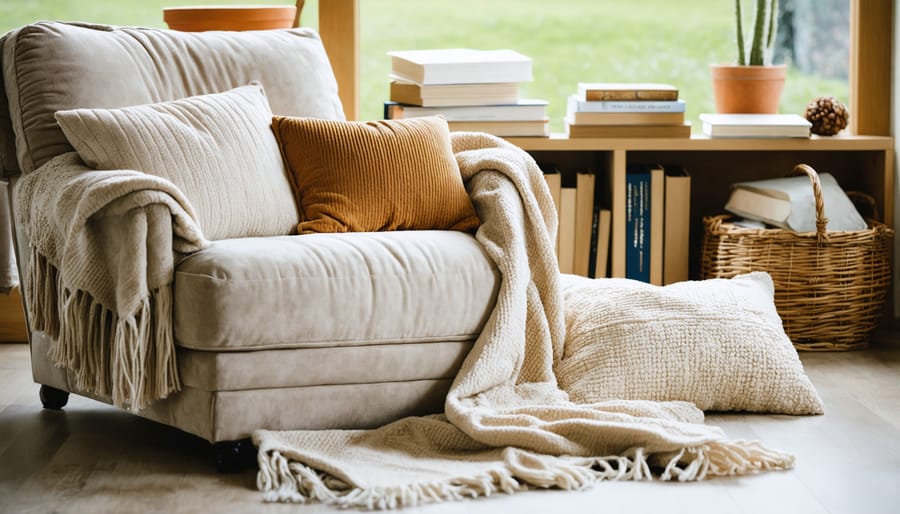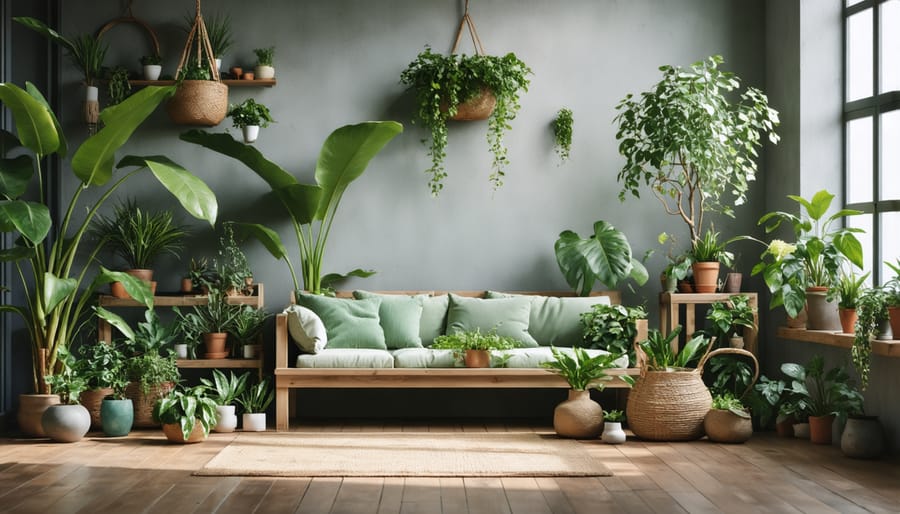Transform your living space into a warm sanctuary by strategically layering soft textiles, adjusting lighting, and incorporating personal elements that speak to comfort. Start with plush throw blankets and textured pillows in coordinating earth tones, then add items to make your home feel cozy like woven baskets, natural wood accents, and flickering candles. Create intimate lighting zones using dimmable lamps and string lights rather than relying on harsh overhead fixtures. Arrange furniture to encourage conversation and relaxation, with seating grouped in intimate clusters rather than pushed against walls. The key to an inviting home lies in engaging multiple senses – incorporate gentle scents from essential oils or baked goods, play soft background music, and ensure every surface offers something interesting to touch or observe. These thoughtful touches transform any space from simply furnished to wonderfully welcoming.
Create Warmth Through Lighting
Layer Your Lighting Sources
Creating the perfect cozy atmosphere starts with a well-planned lighting strategy that combines three essential layers. Begin with ambient lighting – your room’s general illumination from ceiling fixtures or recessed lights. This foundation layer should provide enough light to navigate the space comfortably without feeling harsh or clinical.
Next, incorporate task lighting for specific activities. Think reading lamps beside your favorite armchair, under-cabinet lights in the kitchen, or a desk lamp in your home office. These focused light sources not only serve practical purposes but also create intimate zones within your space.
The final layer – accent lighting – is where the magic happens. Use wall sconces, picture lights, or small table lamps to highlight artwork, architectural features, or cozy corners. Consider installing dimmer switches to adjust the brightness levels throughout the day and create different moods.
Pro tip: aim for at least three light sources per room, positioned at different heights. Warm-toned bulbs (2700-3000K) create a more inviting atmosphere than cool white lights. Don’t forget about natural light – use sheer curtains to soften daylight while maintaining that warm, welcoming glow. String lights or flameless candles can add that extra touch of warmth and whimsy to your lighting scheme.

Choose the Right Bulb Temperature
The color temperature of your light bulbs plays a crucial role in setting the right mood for each room. For living spaces where you want to create a warm, inviting atmosphere, opt for bulbs with a color temperature between 2700K and 3000K. These warm white bulbs emit a soft, golden glow that mimics natural sunset light, perfect for living rooms and bedrooms.
In contrast, save cooler temperatures (4000K-5000K) for task-oriented spaces like home offices or kitchens, where you need clear, focused light. For bathrooms, consider using mid-range temperatures around 3500K, which provide enough brightness for grooming while maintaining a pleasant ambiance.
A pro tip is to layer your lighting with different temperatures. For example, use warmer bulbs in table lamps and wall sconces for ambient lighting, while incorporating slightly cooler temperatures in ceiling fixtures. This creates depth and allows you to adjust the room’s atmosphere throughout the day.
When shopping for bulbs, look for those labeled “soft white” or “warm white” for cozy spaces. Many smart bulbs now offer adjustable temperatures, letting you transition from energizing daylight to relaxing warm tones with just a tap on your phone.

Soft Textures That Welcome Touch
Strategic Textile Placement
Strategic placement of textiles can transform your space from stark to snug with minimal effort. Start by layering different textures in your seating areas – drape a chunky knit throw over the corner of your sofa and add a mix of velvet and linen throw pillows for instant comfort. For maximum impact, position these soft elements where they’ll be both visible and practical.
In living spaces, create cozy conversation zones by placing plush area rugs under seating arrangements – this helps define the space while adding warmth underfoot. Don’t forget to extend the rug a few inches beyond your furniture to create a unified look. Window seats and reading nooks benefit tremendously from cushions and throws, making these spots irresistibly inviting.
Your bedroom deserves special attention when it comes to textile placement. Layer your bed with different textures, starting with soft sheets, adding a quilted coverlet, and topping it with a fluffy duvet. Place a soft runner or small rug on either side of the bed to greet your feet each morning.
In transitional spaces like hallways and entryways, consider adding runner rugs to create visual warmth and reduce echo. Even your dining room can benefit from strategic textile placement – try upholstered chairs or add seat cushions for comfort during long dinner conversations. Remember to rotate your textiles seasonally, switching to lighter fabrics in summer and cozier materials in winter.
Mixing Textures Like a Pro
Creating visual and tactile interest in your home is all about masterfully combining different textures. Start by selecting a base texture from your largest pieces, like a smooth leather sofa or a plush velvet armchair. Layer complementary textures through smaller items – think chunky knit throws, silky cushions, or rough jute rugs.
A foolproof approach is to mix three to four different textures in any given space. For example, pair sleek metal accents with soft wool textiles and natural wooden elements. Don’t forget to include both smooth and rough surfaces – this contrast creates depth and visual interest that naturally draws people in.
When mixing textures, consider their visual weight. Balance heavier textures like shag rugs or thick-weave blankets with lighter ones such as linen curtains or smooth ceramic vases. Natural materials work particularly well together – combine woven baskets with wooden furniture and stone accessories for an organic, harmonious feel.
Remember to distribute textures evenly throughout the room rather than clustering them in one area. Add subtle texture through wallpaper, textured paint, or grasscloth wall coverings for a sophisticated backdrop. Small touches like a furry throw pillow against a smooth cotton sofa, or a rough pottery bowl on a glossy table, can make a significant impact without overwhelming the space.
Color Psychology for Comfort
Warm Color Palettes
Creating a cozy atmosphere starts with choosing the right colors, and understanding basic color theory principles can help you make the perfect choice. Warm color palettes are your best friends when it comes to creating an inviting space. Think rich earth tones, soft terracottas, and gentle browns that remind you of freshly brewed coffee.
Start with a base of creamy whites or warm beiges, then layer with deeper hues like rust orange, burgundy, or golden yellow. These colors naturally create a sense of warmth and comfort, making your space feel like a gentle hug. For a balanced look, consider combining three to four colors: one dominant neutral shade, a medium-toned warm color, and one or two accent colors.
Some fail-proof combinations include:
– Cream + terracotta + chocolate brown
– Warm gray + burnt orange + deep red
– Khaki + mustard yellow + rusty red
– Ivory + caramel + forest green
Remember to test your colors in different lighting conditions, as natural and artificial light can significantly affect how warm colors appear in your space. Start small with throw pillows or artwork before committing to larger elements like wall paint or furniture.
Accent Colors That Work
Adding accent colors is like giving your room a personality boost without overwhelming the space. Choose two to three complementary colors that make you feel warm and happy, then sprinkle them throughout your room in strategic places. Think burnt orange throw pillows, deep teal vases, or rich burgundy curtains that pop against neutral walls.
The key is to follow the 60-30-10 rule: use your main color for 60% of the room (usually walls and large furniture), a secondary color for 30% (upholstery and textiles), and your accent color for just 10% of the space. This creates visual interest without chaos.
For a cozy vibe, stick to warm undertones in your accent pieces. Rich jewel tones like emerald green and sapphire blue add sophistication, while earthy terracottas and mustard yellows bring warmth. Remember to repeat your accent colors at least three times in a room – perhaps through artwork, cushions, and a cozy throw blanket – to create a cohesive look that feels intentional rather than random.
Start small with easily changeable items like pillows or ceramics. This way, you can experiment until you find the perfect color combination that makes your space feel just right.
Personal Touches That Matter
Photo Displays and Artwork
Personal photos and artwork transform your space from a simple house into a story-filled home. Create an eye-catching gallery wall by mixing family photos with favorite art pieces, using matching frames for a cohesive look or eclectic frames for a more casual vibe. When arranging photos, start with a central piece and work outward, maintaining roughly equal spacing between frames.
Consider creating themed collections, such as travel memories in the hallway or family milestones in the living room. For a professional look, hang artwork at eye level (approximately 57-60 inches from the floor to the center of the piece), and use proper hanging hardware to keep everything secure and level.
Don’t limit yourself to walls – try placing framed photos on floating shelves, mantels, or side tables in small groupings of three or five. Mix in personal mementos like children’s artwork, concert tickets, or vacation souvenirs to add depth and personality. Remember to rotate your displays seasonally to keep your space feeling fresh and prevent photos from fading in direct sunlight.
For a modern touch, try incorporating digital photo frames that rotate through your favorite memories, especially in high-traffic areas like the kitchen or entryway.
Meaningful Objects and Collections
Personal objects and collections tell your unique story and add soul to your living space. Consider displaying cherished family photographs in vintage frames, arranging them in an eye-catching gallery wall that sparks conversation. Showcase meaningful travel souvenirs, like that hand-woven basket from Morocco or those delicate ceramics from Japan, to bring your adventures home.
Create thoughtful vignettes with items that hold special memories – perhaps your grandmother’s antique teapot alongside your favorite books, or a collection of seashells gathered from family beach trips. These personal touches transform a house into a home that reflects your journey and experiences.
Don’t feel pressured to display everything at once. Rotate collections seasonally to keep your space fresh and prevent cluttering. Group similar items together for visual impact – vintage cameras on a floating shelf, inherited china in a glass cabinet, or carefully curated art pieces that speak to your aesthetic.
Remember, the most inviting homes aren’t perfectly curated showrooms – they’re spaces filled with objects that make you smile and stories waiting to be shared with guests.
Natural Elements for Warmth

Indoor Plants That Thrive
Adding plants to your home not only enhances its aesthetic appeal but also creates a naturally cozy atmosphere. When choosing indoor greenery, focus on plants that are both beautiful and easy to maintain. The Snake Plant (Sansevieria) is perfect for beginners, thriving in various light conditions and requiring minimal care. Its tall, striking leaves add vertical interest to any room.
Pothos is another excellent choice, with its cascading vines that can transform shelves and corners into lush green spaces. Learn how to style indoor plants to maximize their impact in your space. The Peace Lily offers elegant white blooms and helps purify the air, while ZZ plants add a touch of sophistication with their glossy, dark green leaves.
For smaller spaces, consider Chinese Evergreens or Spider Plants, which adapt well to various environments and create instant coziness. Place them in decorative pots that complement your décor, and group different plants together to create eye-catching displays. Remember to position plants away from direct drafts and heating vents, and maintain consistent watering schedules to keep them thriving and beautiful all year round.
Natural Materials and Textures
Natural materials have an innate ability to make any space feel more welcoming and grounded. Wood elements, in particular, bring warmth and character to your home. Consider incorporating wooden furniture pieces, exposed beams, or even a reclaimed wood accent wall to add rustic charm. Raw wood textures, whether in flooring or decorative elements, create an immediate connection to nature.
Stone features, such as a slate fireplace surround or natural pebble coasters, add an organic, earthy feel to your space. Layer different textures by mixing materials – think chunky wool throws draped over leather furniture, or woven grass baskets paired with smooth ceramic vases. Natural fiber rugs, like jute or sisal, not only feel wonderful underfoot but also add visual texture to your floors.
Don’t forget about smaller touches: cork coasters, bamboo organizers, or driftwood art pieces can all contribute to the natural aesthetic. Living elements like indoor plants complement these materials perfectly, creating a harmonious blend of textures and bringing life to your space.
For maximum impact, try to incorporate at least three different natural materials in each room, but be careful not to overwhelm the space. The key is to create a balanced, organic feel that makes your home feel like a natural sanctuary.
Creating a warm and inviting home doesn’t have to be complicated or expensive. As we’ve explored throughout this guide, small changes can make a significant impact on your living space. From optimizing natural light and selecting the right artificial lighting to incorporating soft textiles and personal touches, you can create a cozy home on any budget using these simple strategies.
Remember to start with the basics: good lighting, comfortable seating, and welcoming textures. Then, layer in personal elements like family photos, cherished collections, and meaningful artwork. Don’t forget the power of natural elements and pleasant scents to enhance the overall atmosphere.
Take it one step at a time – you don’t need to transform your entire home overnight. Begin with the room where you spend the most time, and gradually implement these changes throughout your space. The key is to create an environment that reflects your personality while providing comfort and warmth for both you and your guests.
Now that you have all these tools and tips at your disposal, it’s time to start making your home the cozy sanctuary you’ve always dreamed of. Happy decorating!
